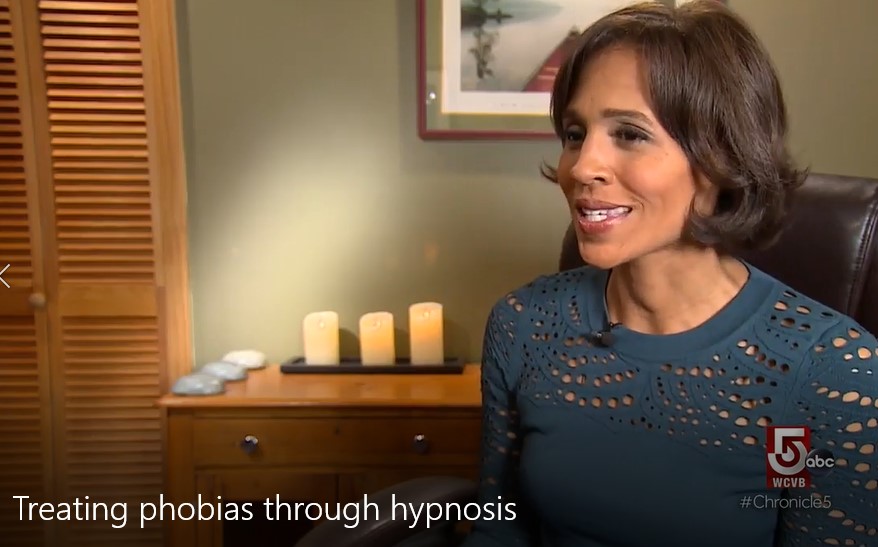
Video: Paul on WCVB’s Chronicle


 If you are feeling depressed, you may want to consider working with a professional who offers hypnosis, according to a recent study appearing in the American Journal of Clinical Hypnotherapy (AJCH).
If you are feeling depressed, you may want to consider working with a professional who offers hypnosis, according to a recent study appearing in the American Journal of Clinical Hypnotherapy (AJCH).
For this investigation, researchers conducted a meta-analysis of previous studies to assess the impact of hypnotic interventions on people who were diagnosed with various forms of depression.
In all, 197 records were screened across ten studies and thirteen trials. The results showed that persons who were depressed and received some form of clinical hypnotherapy saw a 76% improvement of their symptoms when compared to those in control groups (meaning no hypnotic interventions).
Guy Counseling spoke to licensed psychotherapist Katie Ziskind in St. Niantic, CT about her use of hypnotherapy with depressed clients. Here is what she told us:
“Hypnotherapy is a wonderful way to complement traditional talk counseling. Hypnotherapy can help with addiction, anxiety, and depression,” she said.
“It is considered a complementary alternative medicine and a therapy that looks deep into your true self. Unfortunately, many would say that Western medicine treats the physical symptom where hypnotherapy treats the emotional source.
Hypnotherapy includes your mind, your body, and your spirit, and usually, sessions are a few hours and deep. You get to access your inner consciousness and work through very intense emotions from a calm, relaxed place,” adds Ziskind
How hypnotherapy is used for depression
The critical thing to bear in mind with hypnotherapy is that clinicians use it as an adjunct to therapy and not as a standalone treatment.
For example, some helping professionals use a cognitive hypnotherapy model where a combination of cognitive behavioral therapy, (CBT) is combined with hypnosis.
Using this approach, CBT and hypnosis are used to help you to feel more relaxed and boost self-esteem. Additionally, this approach encourages positive mindfulness to lift mood.
As part of therapy, unhealthy cognitions are explored and disrupted. Later, post-hypnotic suggestions are applied to reaffirm healthier ways of thinking.
Previous research on the use of hypnotherapy has demonstrated hypnotic interventions may be helpful in reducing pain and anxiety after surgery.
Other lines of research have shown hypnotherapy to be beneficial with reducing feelings of panic and fear, particularly for people with a specific phobia.
 Investigators for the AJCH study state, “The findings of our meta-analysis show that hypnosis is a very effective treatment for reducing the symptoms of depression.” Additionally, they say, “Our results suggest that the efficacy of hypnosis in treating depression is comparable to that of other psychological interventions for the problem.”
Investigators for the AJCH study state, “The findings of our meta-analysis show that hypnosis is a very effective treatment for reducing the symptoms of depression.” Additionally, they say, “Our results suggest that the efficacy of hypnosis in treating depression is comparable to that of other psychological interventions for the problem.”
The researchers encourage clinicians to give serious consideration to the use of hypnosis as part of a comprehensive approach when working with depressed clients.
Expectancy Theory
As with any study, there are limitations. Scientists for this investigation point out that some of the perceived benefits related to hypnosis may be linked to a phenomenon called the expectancy theory; a $10.00 term used to describe a dynamic where a person responds in affirmatively because they expect a benefit.
Here is an example
Let’s say you are feeling anxious. As a result, I give you a “magic glass of water” and tell you that drinking it will make you calmer. Moments later, you take a few sips and instantly feel a sense of peace.
According to the expectancy theory, because you believed drinking that water would be beneficial, you immediately felt better.
But here is the thing – does it really matter if the expectancy theory somehow influences the outcome? At the end of the day, if there is a reduction in symptoms, isn’t  that what matters?
that what matters?
It’s important to point out that hypnosis doesn’t work for everyone (investigators state this in the study). Still, it does appear that for some folks, hypnotic interventions, when combined with other forms of therapy, can help to reduce feelings of sadness.
When you take away the “woo-woo” factor (thanks to misrepresentations in popular culture), hypnosis really is nothing more than a natural, mindful approach to wellness.
By: John D. Moore Men’s Blog

 Hypnosis can reduce pain by up to 42% and may offer a genuine alternative to painkillers, according to UK researchers.
Hypnosis can reduce pain by up to 42% and may offer a genuine alternative to painkillers, according to UK researchers.
They said their findings suggest that hypnotic intervention could deliver “meaningful pain relief for most people” and, therefore, may be an “effective and safe alternative” to drug intervention.
The analysis, led by psychologist Dr Trevor Thompson from the University of Greenwich, found that hypnosis was more effective with people who are especially amenable to suggestion. “This is by far the largest review of its kind and presents very compelling evidence”.
However, it also found that those who were moderately suggestible – essentially most people – saw a 29% drop in pain after hypnosis.
Data was used from 85 studies across 14 countries, with a total of 3,632 people subjected to different forms of pain stimulation including extreme cold, heat,  pressure, exercise and even lasers.
pressure, exercise and even lasers.
People typically rated the pain they felt as 5.5 on a scale of zero to 10, according to the study published in the journal of Neuroscience and Bio-behavioral Reviews.
According to the researchers, a five level of pain would significantly disrupt daily lives and have most people using medication.
Dr Thompson said: “This is by far the largest review of its kind, examining the effects of hypnosis in over 3,500 people, and presents very compelling evidence.
“About 15% of the population are highly receptive to hypnosis, and those people saw just over a 40% drop in pain,” he noted.
“Based on these findings, most people would experience around a 30% drop in pain or more, which is generally considered to be clinically meaningful pain relief,” he said.
Dr Thompson highlighted that the misuse of prescription painkillers such as codeine and fentanyl had increased massively over recent years and was a crisis in some countries, most notably the US.
 “Our findings suggest hypnosis could be a safe and effective alternative,” he said. “It can be administered quickly, cheaply and easily at home with a 20-minute audio recording.”
“Our findings suggest hypnosis could be a safe and effective alternative,” he said. “It can be administered quickly, cheaply and easily at home with a 20-minute audio recording.”
He added: “The next step is to extensively test hypnosis on people with chronic pain, such as back conditions, which people live with every day.
“Available data on this are not of a high enough quality or quantity,” he said. “We need to go and try this with people in their day-to-day lives.”
By: Nursing Times News Desk

 Last summer, at age 14, Sue Jones suffered from stabbing pains in her abdomen that got so intense, “I couldn’t walk.”
Last summer, at age 14, Sue Jones suffered from stabbing pains in her abdomen that got so intense, “I couldn’t walk.”
She spent three weeks in a wheelchair while doctors ruled out everything from digestive problems to appendicitis. Finally, after a four-night stay at BC Children’s Hospital in Vancouver, she got a diagnosis: acute anxiety.
An honor student, Sue is thin, dark-haired and lily pale. (Her parents requested a pseudonym to protect her privacy.) When a doctor recommended hypnosis, she balked at first. “I thought of it as black magic, like witchcraft,” she says. But neither breathing exercises, nor anti-depressants, had taken away the pain.
So, in early September, she visited Dr. Leora Kuttner, a pediatric psychologist who specializes in clinical hypnosis, a technique for leveraging the brain’s healing abilities during a trance state.
Kuttner’s office has a rumpus-room feel, with toys, plants and colorful pictures scattered about. Settling into a plump beige armchair by the window, Sue breathed slowly as the psychologist asked her to “go to a quiet place.” She chose a beach. Then, in a soft, soothing voice, Kuttner suggested that she imagine a “protection skirt” that could shield her from stomach pain.
Sue pictured herself covered in “a golden, shimmery, transparent cocoon, floating up in the air above this beach.” For a few moments, she felt as though she had left the room. When Kuttner called her out of her reverie, “I was surprised where I was.” Another surprise: the pain was gone.
Sue keeps a recording of her “protection skirt” hypnosis handy on her phone – all 5 minutes, 56 seconds of it. She is still learning to keep anxiety at bay, but if the abdominal pain ever comes back, she says, “I know how to deal with it.”
Hypnosis isn’t just for hucksters and Hollywood villains any more. Neuroscience studies have shown that this mind-body therapy affects the brain in extraordinary ways. Clinical trials have demonstrated its effectiveness in treating anxiety, phobias, skin rashes, irritable-bowel syndrome and acute and chronic pain.
In France and Belgium, anesthesiologists are offering hypnosis combined with local anesthetic as an alternative to general anesthesia in surgery. In North America, medical centers such as the Mayo Clinic have added hypnosis to their pain-management tools.
Hypnosis doesn’t work for everyone, notes Dr. Amir Raz, Canada Research Chair in the cognitive neuroscience of attention at McGill University and the Jewish General Hospital in Montreal. But “in my opinion, it’s completely underused.”
That may be changing, especially in pediatrics. Over the past four years, Kuttner has been invited to teach hypnosis at the Mayo Clinic, Alberta Children’s Hospital in Calgary and the Hospital for Sick Children in Toronto. Kuttner, who developed her techniques more than three decades ago, says she’s “thrilled” by the uptake.
As with mindfulness meditation, hypnosis harnesses the brain’s natural abilities to regulate the body and control the random thoughts that ricochet through our minds, says Dr. David Patterson, a University of Washington psychologist who has studied hypnosis since the 1980s, in a series of clinical trials financed by the U.S. National Institutes of Health.
But, he adds, meditation can take weeks or months of practice before it helps patients dial down pain. With hypnosis, “the relief is just a lot quicker and more dramatic.”
Hypnosis reduces our awareness of what’s going on around us, even as it increases our attention and openness to new ideas. The brain’s  command center lets its guard down, allowing the therapist’s suggestions to embed themselves into the parts of our grey matter that regulate our thoughts, perceptions and physiology, Patterson says. “It’s as if you’re talking directly to the brain.”
command center lets its guard down, allowing the therapist’s suggestions to embed themselves into the parts of our grey matter that regulate our thoughts, perceptions and physiology, Patterson says. “It’s as if you’re talking directly to the brain.”
At Legacy Oregon Burn Center in Portland, Ore., Dr. Emily Ogden, a psychologist, uses hypnosis to help patients cope with the most excruciating injuries you can have.
In the facility’s bedroom-sized intensive-care units, machinery for monitoring vital signs beeps nonstop as nurses and doctors cut away layers of clothing and scorched flesh. The air is putrid-sweet, the smell of open wounds.
Often, the pain of the burn itself pales next to the agony of having dead tissue removed in a process called debridement, or a patch of healthy skin shaved and grafted onto a wound. Then there are the dressing changes. Every day or so, nurses replace fluid-soaked gauze to prevent a burn victim’s greatest threat: infection. The sudden gust of cold air on exposed wounds can be torturous, even with painkillers.
Burn patients tend to be open to hypnosis, Ogden says, but they often add something such as, “I’m not going to squawk like a chicken, am I?”
After reassuring them that no, she won’t make them cluck, Ogden stands by the bedside and asks the patient to imagine stepping down a flight of stairs as she counts backward from 20. Once the patient is deeply relaxed, she gives a series of hypnotic “suggestions,” or instructions for the brain.
For example, “When a nurse touches you on the shoulder, you will return to the feeling of relaxation you have now,” she might say. “During the procedure, you will have no feelings other than comfort and relaxation. Later, you’ll be surprised at how easily it goes for you.”
As simple as it sounds, the technique usually works, says Ogden, who began offering hypnosis six months ago. “It has proven to be such a beneficial and effective intervention.”
Hypnosis stimulates specific brain activity, according to a 2016 study from Stanford University. Researchers found three brain changes in adults who scored high in susceptibility to hypnosis and these changes occurred only while they were hypnotized.
Using a brain-imaging technique called fMRI, researchers found decreased activity in the brain’s salience network, the inner “air-traffic controller” that processes stimuli and preps us for action.
Secondly, they saw greater connectivity between the brain’s executive-control network and the insula, a grape-sized region deeper in the brain that helps us “control what’s going on in the body, and process pain,” the study’s co-author, psychiatrist Dr. David Spiegel, says.
Finally, the researchers observed reduced connections between the executive-control center and the “default-mode” network, involved in self-reflection. This could lead to a disconnect between a person’s actions and their awareness of their actions, Spiegel says.
He describes hypnosis as a “very powerful means of changing the way we use our minds to control perception, and our bodies.” If more practitioners had training to use it, hypnosis could make “a huge difference” in the opioid epidemic, he adds.
In a previous study, published in The Lancet, Spiegel and colleagues instructed patients in self-hypnosis techniques before they underwent vascular or kidney procedures.
Compared with patients receiving standard care, the hypnosis group used significantly less pain medication (fentanyl and midazolam). Spiegel’s team is now testing the same approach in knee- and hip-surgery patients.
He notes that the risk of addiction increases when people are on opioid painkillers for more than three days. If patients can get through the post-surgical period faster, “you can prevent them from getting hooked.”
 But hypnosis has an image problem. Unlike mindfulness, it lacks Zen-master cachet. Doctors and patients have trouble forgetting the dangling pocket watches of stage hypnosis, or the bad guys who put sleeper agents under “mind control” in movies such as The Manchurian Candidate.
But hypnosis has an image problem. Unlike mindfulness, it lacks Zen-master cachet. Doctors and patients have trouble forgetting the dangling pocket watches of stage hypnosis, or the bad guys who put sleeper agents under “mind control” in movies such as The Manchurian Candidate.
Despite solid evidence from clinical trials, the medical field’s approach to hypnosis has been “extremely careful and conservative,” Raz says.
And let’s face it: For every credible scientist studying hypnosis, there are hundreds of charlatans touting self-hypnosis CDs or sessions on Skype as a miracle cure for everything from obesity to cancer. In the land of psychics and crystal magic, anyone can become a “certified hypnotherapist” in a month or less. Rampant quackery “gives us a bad name,” Patterson says.
Adults tend to insist they are impervious to hypnosis, even if they’ve never tried it, Raz says. They think of it as “feeble-mindedness, or the ability to be manipulated.”
But in fact, people who respond to hypnosis may have better co-ordination between brain areas that “integrate attention, emotion, action and intention,” according to a 2012 study published in the Archives of General Psychiatry.
About 10 to 15 percent of adults are “highly hypnotizable,” meaning they can easily slip into a trance and act on hypnotic suggestions. The same percentage of adults do not respond to hypnosis at all, while the rest are somewhere in between. The trait may be genetic, researchers say. But imagination also plays a role.
Responsiveness to hypnosis reaches its peak between the ages of 8 and 12, says Kuttner, who began using hypnosis in the mid-1980s to help children cope with pain in the oncology ward at BC Children’s Hospital.
She documented her techniques in No Tears, No Fears, a short film featuring eight kids with cancer, aged 3 to 12. Guided by Kuttner, the children went through procedures such as spinal taps with only local anesthetic at the needle site. (At the time, general anesthesia in children was reserved for special circumstances, such as major surgery.)
Most children can easily imagine an invisible “magic glove” that keeps needles from hurting, or a fantasy world free of pain, Kuttner says. Concentrating on these beliefs can have analgesic effects. With a fond smile, she recalls a child with leukemia who spent her treatments in an imaginary land of candy.
A more recent patient, 17-year-old Isabella Hay, says working with Kuttner helped her overcome muscle twitches and symptoms of obsessive-compulsive disorder. Starting at the age of 4, Isabella learned to visualize entering a room and turning off switches that controlled her nervous ticks.
When Isabella received a diagnosis of OCD at the age of 13, Kuttner taught her how to focus on her breathing and picture herself in calm place, using a form of self-hypnosis. The technique has given her control over compulsive behaviors, such as a need to touch a rock a certain number of times, Isabella says.
She used to feel panicky at the idea of sleeping away from home. Now, she is graduating from high school with acceptance letters from both the University of British Columbia and Queen’s University. Knowing that the brain is strong enough to “transport you from the thoughts,” Isabella says, “I feel more secure and confident, and less vulnerable in my own head.”
Hypnosis techniques are relatively easy for health-care professionals to learn, Kuttner says. But like other specialists interviewed for this article, she cautions patients against seeking hypnosis from someone with no medical training. “Things can go haywire.”
A lay hypnotist could fail to recognize the signs of psychosis, or encourage someone to regress to an earlier life stage filled with traumatic memories, “and they won’t have a clue how to help the person.”
Kuttner recalls treating a patient who had gone to a lay hypnotist for headache relief but came away weeping and confused. Hypnosis needs to be in the hands of “someone who respects it, and knows what they are doing,” she says. “This is powerful stuff.”
In hypnosis circles, the word “powerful” comes up a lot. But it’s hardly an overstatement when you consider the work of Dr. Marie-Elisabeth Faymonville, director of the pain clinic and palliative care at the University Hospital of Liège, Belgium.
Hypnosis allows patients to avoid general anesthesia in surgeries ranging from mastectomies to heart-valve replacements, Faymonville says.
Since 1992, she has treated more than 9,500 surgery patients with “hypno-sedation,” combining hypnosis with small amounts of local  anesthesia. Of those patients, just 18 had to switch to general anesthesia. “It’s really rare,” she says, in German-accented English.
anesthesia. Of those patients, just 18 had to switch to general anesthesia. “It’s really rare,” she says, in German-accented English.
The method appeals to patients who want to be “aware during surgery, but comfortable.” Patients do not get a dry run. Instead, Faymonville assesses their level of motivation and confidence in the surgical team, and their ability to co-operate.
Hypno-sedation works because the patient wants it to work, she says: It’s the opposite of “mind control.” The anesthesiologist’s job is to use hypnotic techniques and communicate with the patient, but the patient must collaborate, “so he puts himself in the hypnotic state.”
She emphasizes that unlike the cross-section of patients you might find in the average hospital, her patients are “highly motivated” to stay conscious during surgery. But in general, she adds, doctors tend to underestimate the resources patients can access with their own minds. “Hypnosis is a talent, a gift from nature.”
THE GIFT OF HYPNOSIS
The ability to be hypnotized is a talent, like an ear for music, researchers say. The easiest way to know if you have it is to give it a try. So, I ask Dr. Lance Rucker, president of the Canadian Society of Clinical Hypnosis, if he’ll hypnotize me.
A dentist by training, Rucker teaches hypnosis to third-year dentistry students at the University of British Columbia, where it’s part of the required curriculum.
Dentists need to learn the basics of hypnosis to “avoid abusing the trance state,” he says. People drift in and out of light trances throughout the day, whether they’re on “autopilot” for the daily commute, or so engrossed in an X-Men flick that they forget it’s a movie.
Dental patients – triggered by memories of needles, drills and frozen-gums past – are often in a daze even before they lie on the chair. When patients are in this vulnerable state, a dentist’s soothing words (“let’s make sure you’re comfortable”) can help make it so. On the flip side, stock phrases such as, “this might hurt a little,” may intensify pain and fear, he says.
Rucker emphasizes that reputable practitioners will not use hypnosis for purposes outside their medical specialty. He asks if I have a dental issue I’d like to resolve. An overactive gag reflex, perhaps? Or a fear of dental fillings?
I am definitely a grinder. That may not be easily fixed, depending on the root cause, he replies. But he’s willing to give it a go.
We sit in the front seats of his scarlet Acura, parked outside a cluster of big-box stores near his home in Burnaby, B.C. The windows are closed to shut out the rumble of traffic and the air is warm and stuffy. I am drowsy already.
In a soft, calm voice, Rucker asks me to take myself to “an internal space, a creative space.” As I relax, he says, my inner awareness can let me know “what it’s all about, and has been all about – the clenching, the grinding.”
A symbol or realization may come to mind. He pauses for a few moments. Then he suggests that I ask my inner self whether it can let the grinding go, “or whether there is some part of you that may wish to hold on to it.”
As his voice meanders, I have a clear picture of a big black dog with massive metal jaws. Could my clenching be a hard-wired defense mechanism? It’s an obvious symbol. But as it turns out, my inner guard dog refuses to back down easily. Later that day, my jaw feels as tight as ever.
A life-long grinding habit could be a problem that a single session in a parked car cannot solve. I might give hypnosis another try. But maybe I just don’t have the gift.
By: Adrianna Barton

 When Anna Wall realized she was in labor with her son Luke, the 29-year-old first-time mom in Austin, Texas focused her breathing until she had hypnotized herself into a state of deep relaxation. Her eyes closed, she remained in deep hypnosis until delivering her baby 10 hours later.
When Anna Wall realized she was in labor with her son Luke, the 29-year-old first-time mom in Austin, Texas focused her breathing until she had hypnotized herself into a state of deep relaxation. Her eyes closed, she remained in deep hypnosis until delivering her baby 10 hours later.
“I could hear everything and respond when I needed to, but I was so relaxed that I remember falling asleep between contractions,” she tells WebMD.
Wall says even the last 45 minutes of vaginally delivering her 9 1/2-pound baby involved no screaming or pushing. “I kept breathing deeply and just felt my body move the baby down. And then he literally slid out,” she recalls.
She credits her calm, unmedicated childbirth to hypnobirthing, the increasingly popular mind-body technique among parents seeking a natural birthing experience with more patient control and less pain than existing methods.
How It Works
Publicized by celebrity moms like Jessica Alba and Tiffani Thiessen, self-hypnosis in childbirth has been around for centuries, according to experts. However, only in the last three decades have classes begun to develop under different programs such as “HypnoBirthing – The Mongan Method,” “Hypnobabies,” “The Leclaire Hypnobirthing Method,” and “Hypbirth.”
Despite the variety of programs, the philosophy remains the same: nature intended for women to give birth relatively easily, but the fear of childbirth incites physical pain.
“We have convinced ourselves that labor is risky,” says Marie Mongan, MEd, MHy, founder of HypnoBirthing – The Mongan Method.
Fear during labor activates our primal fight-or-flight mechanism, causing stress hormones called catecholamines to slow down digestion, make the heart speed up, force blood to the arms and legs, and ultimately deplete blood flow to the uterus, creating uterine pain and hindering the labor process.
make the heart speed up, force blood to the arms and legs, and ultimately deplete blood flow to the uterus, creating uterine pain and hindering the labor process.
According to Mongan, who is a hypnotherapist and hypnoanesthesiologist, it is physically impossible for the body to be relaxed and in fight-or-flight mode. By replacing fear with relaxation, a different set of chemicals come into play: oxytocin, labor hormones called prostaglandins, and endorphins combine to relax the muscles and create a sense of comfort.
What Hypnobirthing Teaches
“At my very first pregnancy appointment, I said ‘I want to do this without drugs,'” Wall recalls. But when she brought up the popular Bradley method, which focuses heavily on the support of a childbirth partner to help cope with pain, her doctor suggested hypnobirthing as an easier alternative.
Wall and her husband took Mongan’s HypnoBirthing course, consisting of five classes, 2 1/2 hours each. Courses cost between $275 to $350, depending on location and provider.
With the help of a course book and hypnosis CDs, Wall and her husband learned breathing and visualization techniques. She was taught to envision an easy birth, with her cervix opening wide, allowing the baby to come out effortlessly.
Every day, they practiced affirmations like, “I relax and my baby relaxes,” and “My baby is the perfect size for my body.” Her husband later repeated those key phrases to her as he coached her during labor.
Wall says daily practice helped her eliminate distractions and reach a state of deep relaxation earlier each time.
 She also learned to reject references to difficulty during childbirth, replacing the words “contraction” and “pain,” with terms such as “surge” and “sensation” instead.
She also learned to reject references to difficulty during childbirth, replacing the words “contraction” and “pain,” with terms such as “surge” and “sensation” instead.
Other hypnobirthing courses teach similar techniques with some variations.
“Hypnobabies” trains mothers to self-hypnotize with their eyes completely open during the process, says Carol Thorpe, one of its hypnotherapist doulas. Thorpe says the course also provides comprehensive childbirth training beyond self-hypnosis.
Still other hypnobirthing methods allow for parents to take a whole course in one day, or entirely at home.
Calm Approach
Diana Weihs, MD, Wall’s delivering ob-gyn, estimates about 5% of her patients have used hypnobirthing.
“There’s something that’s gentler that is not there with the Bradley method,” she says. “It’s harder to watch Bradley patients, knowing that their pain management is not as effective,” says Weihs, a fellow of the American Congress of Obstetricians and Gynecologists.
She attributes the growing popularity of hypnobirthing partly to the method’s openness to medical intervention when necessary, an attitude that she says is often lacking among Bradley patients.
Nurse-midwife Megan Sapp, CNM, FNP, says her Maryland-based practice sees about 40% of patients using hypnobirthing, another 40% using the Bradley method, and the rest using other methods including Lamaze, meditative calm birthing, Birthing from Within, and more.
Sapp tells WebMD that moms who use hypnobirthing tend to have shorter labors compared to other methods.
A 2006 review of five existing studies showed that women who used hypnobirthing techniques were about half as likely to use painkiller drugs, and about one-third as likely to use an epidural.
Safety First
Regardless of the specific hypnobirthing program, there is always the possibility that things don’t go as planned during labor, says David Keefe, MD, professor and chairman of obstetrics and gynecology at New York University’s Langone Medical Center.
“It’s very safe,” he says. “However, the key to a successful natural childbirth is having the attitude that you’re doing this for yourself, not to  please anyone else, and if you can’t continue with it for whatever reason, there is nothing wrong with quitting,” says Keefe, who is a fellow of the American Congress of Obstetricians and Gynecologists.
please anyone else, and if you can’t continue with it for whatever reason, there is nothing wrong with quitting,” says Keefe, who is a fellow of the American Congress of Obstetricians and Gynecologists.
Keefe says that expectant moms using hypnobirthing should choose a doctor who fully supports the method, and he recommends the delivery take place in a hospital with rapid access to emergency C-section facilities and a neonatal care unit in case of complications.
“This was by far the hardest thing I’ve ever done in my life,” says Wall, who admits she did feel intense pain during childbirth, though it was not sharp. “But my experience was perfect. People see my son at the grocery store and say what a peaceful baby he is, and I feel hypnobirthing contributed that to him.”
By: WebMD feature